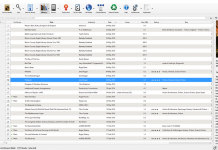Related: Adobe news release on Content Server 4 and ePub.. – D.R.
 Adobe is making its DRM more flexible. Instead of simply choosing between the usual DRM and no DRM, publishers will also be able to password-protect books. That’s the plan for a forthcoming Content Server version, not the current 4.
Adobe is making its DRM more flexible. Instead of simply choosing between the usual DRM and no DRM, publishers will also be able to password-protect books. That’s the plan for a forthcoming Content Server version, not the current 4.
Computerworld has a helpful write-up by Eric Lai. Under the system, you’ll link your books to your Adobe ID account and enter a user name and PW; and you’ll then be able to read the books. You won’t have to use the PW whenever you open the book file. Some progress!
“On the flip side,” Eric notes, “that means a cracked Adobe ID and password could be distributed and used to let pirates read an eBook, just as stolen license keys are used to enable the installation of pirated software.” But how much revenue will actually be lost that way?
The Computerworld piece quotes a certain uppity blogger, who points out this still isn’t genuine social DRM—in other words, still not just names and addresses embedded in books. Besides, in some ways, is the PW approach simply a repackage of one used with eReader with encrypted credit card numbers? In fact, Adobe seems to say as much in this B&N-related FAQ, which will be of interest to Nook owners among others.
Here’s my big concern. With the PW approach, you’re still stuck with Adobe technology. With genuine social DRM, you could use the same ePub file on any e-book-capable device that could read ePub. Now, that would be let ePub serve as a true standard in real life: no “protection” to muck things up. Upstarts like Aldiko or WordPlayer would actually have a better chance in the marketplace and be able to innovate more easily. Adobe in turn could pick up wrinkles from the newcomers and maybe even buy some of them.
Luckily the B&N-related FAQ says: “We anticipate that content distributors will want a range of content protection options, and expect to support these additional options over time. For example, some distributors are using a visible ‘watermark’ as a type of social content protection. At present, Content Server does not support this option, but it is the type of feature under consideration in order to provide the comprehensive cross-platform solution.” That’s not quite name-and-address social DRM but is still different from traditional DRM. I’d hope that the watermarking would not prevent the same file from being used on different platforms without special clients.
None other than Bill McCoy, until recently an Adobe executive, has pushed the idea of social DRM, which would have an even bigger advantage: letting people own books for real. Supposedly no server interaction is required for Adobe’s new DRM system, which, if so, would at help; there’s still the issue of proprietary tech, and whether it would work on future devices. I invite TeleRead community members to examine that. Whatever the case, as book-lover, I’d still feel more comfortable without traditional DRM (social DRM doesn’t count as traditional DRM since it doesn’t limit access).
Look, Adobe could still fare well without traditional DRM in consumer books. I can see it collecting DRM-related revenue from, say, corporate or military applications. If Adobe can’t do DRM strong enough to succeed in those markets, then it should stop seeing the technology as a direct profit center. Adobe doesn’t make that much money from DRM per se anyway. Rather it uses DRM as a lock-in tool and a way of calming down publishers, who seem impervious to the fact it’s so easy to scan paper books.
Detail: I loved Eric’s piece as a whole. But I would like to separate myself from people who think that the “ancillary-market” model will save the book business. Good books take enough time as it is, and I’d rather not see writers forced to be even more entrepreneurial than now or turn into performers. It was right for Dickens. It isn’t right for me. So Adobe’s Nick Bogaty and I would actually be on the same side here. Feel free to disagree!
(Thanks to Wiebe de Jager.)
Update, 7:37 p.m.: I revised certain details, after learning, for example, that the new DRM option could happen before the Content Server reached Version 5. Meanwhile see a reply from Adobe’s Jim Lester, a valued participant in the TeleRead community, as a commenter, despite our philosophical differences. – D.R.


































This watered-down solution is strange to me: this system sounds very similar to what anyone can do with Adobe Acrobat, or cheap PDF-making software: you can add a password to the PDF ebook. It’s fast, it’s simple and it’s free.
Then publishers could avoid the expense of Adobe’s DRM protection; and readers could read the PDF ebooks on any device or with any PDF reading software: no need for Adobe Digital Editions. And no restrictions on how students, scholars, and business-persons can work with the PDF files.
The final act of all this meloDRaMatic nonsense may be near: Apple’s iTablet is coming in the Spring (of 2010). Apple is already negotiating with publishers, to split the revenue 70/30: 70% to the publishers.
This could portend the death of DRM — death due to art failure — and I will be the first one tango-dancing on the grave.
Back in October we announced with B&N, that we were adding a password flavor of DRM for ePubs into the RMSDK (the software that goes onto devices) that matches the current functionality of the eReader DRM, and that this would be in the next release version of the RMSDK 9.1, so that you can read those ePubs on any device/application which used the new SDK, and not just on the Nook.
The feature news from Nick, was basically saying that the next version of Content Server (I’d be surprised if the actual version number is 5 btw) will contain the ability to generate ePubs with the password flavor of DRM, so that you could buy these files, not just from B&N, but from any of the 100+ (and growing 🙂 ) Content Server customers that decided to offer it.